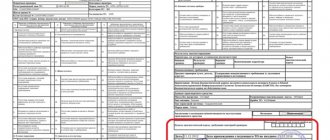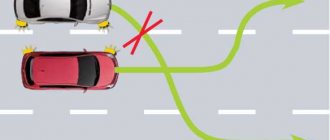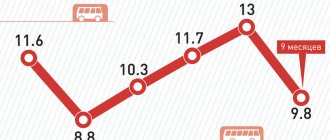The situation with transporting a person in the trunk of a car may seem absurd to many car enthusiasts. However, such situations happen, and sometimes the question arises: is this even legal? To begin with, it is worth noting that such circumstances do not necessarily resemble a crime. Often, when returning from a country picnic, there is simply not enough space in the car to transport all the participants of the event, which is why the bravest person volunteers to ride in the trunk, so as not to call a taxi or look for other ways.
In this case, only one important question needs to be answered - can the driver really be fined for such transportation of a passenger? First of all, it is worth highlighting that the legislation in force in the Russian Federation does not impose any prohibitions on such practices. However, the same traffic rules clearly state the procedure for transporting people by car or other vehicle, which cannot be violated in any way, otherwise you may run into an administrative fine.
You need to understand that the legal act states that a person acting as a passenger must be transported in a seat (if we are talking about a child, then transportation is possible if there is a child seat). Also, when traveling, all persons must wear seat belts, and this applies to absolutely all people in the car. Based on this, we can draw a small conclusion that transporting a person outside the cabin in another place of the car is simply not allowed.
Gotta buckle up
But the conversation with law enforcement will not stop there. This may be followed by a fine for the passengers themselves. A report will be drawn up against each of them under Part 1 of Article 12.29 of the Code of Administrative Offenses and a fine of 500 rubles. If they become indignant and protest, and the driver begins to argue and talk in a raised voice, the traffic police officers have another trump card to pacify the indignant.
In accordance with Article 12.6 of the Administrative Code, for transporting passengers who are not wearing seat belts, the driver may be subject to another administrative penalty in the amount of 1,000 rubles.
How are people allowed to be transported?
As we have already said, transportation can only be carried out in bodies designed for this purpose. Seats and safety belts are required to ensure safety. To ensure safe movement, the law provides for penalties for violating transportation rules.
Usually, people who do not have enough space in the cabin, or workers accompanying the cargo, move in the cargo compartment. In general, riding in the back of a truck is not prohibited , but several points must be observed.
The fine for transporting passengers in a cargo van will not be charged in the following cases:
- The driver of the vehicle has at least 3 years Category D is required only if you need to transport more than 8 people (excluding the driver). If less than eight people are transported, category C will be sufficient .
- In the corresponding compartment, special platforms should be installed that look like side walls.
- The number of seats must be no less than the number of passengers carried .
- The mandatory height at which the seats must be attached should not be less than 20-50cm . The side railing must be at least 80cm .
- It is necessary to thoroughly fasten the seat backs to secure the seating of passengers.
Fines
The fine for transporting people in a cargo van that is not designed for this purpose and does not have the proper equipment is established based on certain circumstances:
- If you simply violate the rules for transporting people, you will have to pay five hundred rubles .
- If transportation is carried out outside an equipped cabin, the fine increases from five hundred rubles to a thousand .
- If incorrect transportation of minor passengers is detected, the driver undertakes to pay an administrative fine in the amount of three thousand rubles . Regarding officials, the law obliges them to pay 25 thousand rubles . A legal entity can also be punished and ordered to pay up to one hundred thousand rubles .
Possibility of evading a fine
If the transportation of people in the back of a truck, for which you were fined, was carried out, in your opinion, legally , you can challenge such a punishment within ten days from the date of the accusation.
You will have to prove that all requirements have been met , and, if necessary, provide witness testimony and video recordings. If you are unable to challenge the fine yourself, remember your legal right to seek help from lawyers who will help you assert your rights and drop illegal charges.
Arms, legs, head...
The vast majority of passengers who stick various parts of their bodies out of the windows of moving cars are not aware of all the risks. This behavior even acquired the features of a certain tradition. For example, when celebrating graduations or weddings among the younger generation, it is good form to ride with the body hanging out of the hatch. At the same time, the car is moving at considerable speed.
Such behavior is not permitted by law, and it is not a matter of morality, of course. Moreover, not only passengers, but also the driver of the vehicle are held administratively liable.
Article 12.23 of the Code of Administrative Offenses of the Russian Federation clearly and unambiguously prohibits the transportation of passengers outside the cabin or cabin:
- If this requirement is violated, the passenger may receive a fine of 1,000 rubles.
- If a minor passenger looks out of the window, the amount of administrative punishment increases to 3,000 rubles.
- In addition, according to Article 12.6 of the Code of Administrative Offenses of the Russian Federation, for transporting unbelted passengers who were leaning out of the car hatch, the driver will face a fine of 4,000 rubles.
- As for the irresponsible passenger, he faces a penalty of only 500 rubles.
- Paragraph 8 of Article 22 of the Traffic Regulations prohibits transporting more than the permitted number of people inside the cabin, as well as placing passengers outside the cabin. The trunk, roof, and hood are prohibited areas.
Transportation rules
Transportation of people can be carried out both in cars and buses, and in specially equipped trucks. In this case, the driver must have a license of the appropriate category and must comply with the conditions of transportation provided for by the traffic rules.
Transporting people in the back of a truck is permitted if the driver has a category “C” or C1″ license for three or more years. To transport people in a truck in the amount of 8 - 16 people (including passengers in the cabin), you must have a license of category “D” or subcategory “D1”.
To transport more than 16 passengers in a truck (including passengers in the cabin), the driver must have a category “D” license (Section 22.1 of the Traffic Regulations).
In addition to the requirements for drivers transporting people, traffic regulations also contain rules for the transportation itself. So:
- in accordance with clause 22.3, 22.9 of the Traffic Regulations, the number of passengers transported must correspond to the technical characteristics of the vehicle;
- in accordance with clause 22.7 of the traffic rules, boarding or disembarking of people until the vehicle comes to a complete stop, as well as the movement of passenger vehicles with open doors or opening doors until the vehicle comes to a complete stop;
- in accordance with clause 22.5 of the Traffic Regulations, the transportation of passengers in the back of a truck that is not designed and not equipped for the transportation of people is prohibited. The exception is when a passenger is accompanying cargo located in the back of a truck and only if there is a seat below the level of the side of the body;
- in accordance with clause 22.4 of the Traffic Regulations, the driver of a truck carrying passengers in the back of a vehicle is obliged to explain to them the rules for boarding, disembarking and positioning in the back of the vehicle;
- in accordance with clause 22.8 of the traffic rules, the transportation of passengers outside the cabin of a car or tractor is prohibited, with the exception of trucks adapted for the transportation of people;
- in accordance with clause 22.8 of the traffic rules, the transportation of passengers in cargo trailers, caravan trailers, or in the cargo compartments of motorcycles and other self-propelled vehicles is prohibited.
Clause 22.9 of the traffic rules is specifically reserved for describing the rules for transporting children in the passenger compartments and cabins of cars. So:
- It is prohibited to transport children under 7 years of age without securing them with special restraint devices;
- It is prohibited to transport children from 7 to 11 years old in the front seats without special securing devices, and in the rear seats - without the use of special securing devices or standard seat belts;
- It is prohibited to transport children under 12 years of age on the back seat of a motorcycle;
- in accordance with clause 11 of the traffic rules, the organized transportation of children is prohibited in the absence of special identification marks on the vehicle. Special identification signs include “Speed limit” and “Transportation of children”.
Article 12.21 of the Code of Administrative Offenses of the Russian Federation. Violation of cargo transportation rules, towing rules (current edition)
Commented article. 12.21 of the Code of Administrative Offenses of the Russian Federation provides for administrative liability for violation of the rules for the transportation of goods and towing rules.
Committing this act entails a warning or the imposition of an administrative fine in the amount of five hundred rubles.
The object of the commented article is public relations in the field of state regulation of cargo transportation and towing.
The objective side of the act in question is a violation of the rules for the carriage of goods, as well as the rules of towing.
The mass of the transported cargo and the load distribution along the axles must not exceed the values established by the manufacturer for this vehicle (see clause 23.1 of the Russian Traffic Regulations).
Before starting and while driving, the driver is obliged to control the placement, fastening and condition of the load in order to avoid it falling and creating obstacles to traffic (see clause 23.2 of the Russian Traffic Regulations).
Transportation of cargo is permitted provided that it:
does not limit the driver's visibility;
does not complicate control and does not affect the stability of the vehicle;
does not cover external lighting devices and reflectors, registration and identification marks, and does not interfere with the perception of hand signals;
does not create noise, does not create dust, does not pollute the road or the environment.
If the condition and placement of the cargo do not meet the specified requirements, the driver is obliged to take measures to eliminate violations of the listed transportation rules or stop further movement.
A load protruding beyond the dimensions of the vehicle in front and behind by more than 1 m or on the side by more than 0.4 m from the outer edge of the side light must be marked with identification signs “Large load”, and in the dark and in conditions of insufficient visibility In addition, in front - with a white light or reflector, and at the rear - with a red light or reflector (see clause 23.4 of the Russian Traffic Regulations).
Transportation of heavy and dangerous goods, movement of a vehicle whose overall dimensions, with or without cargo, exceed 2.55 m in width (2.6 m for refrigerators and isothermal bodies), 4 m in height from the surface of the roadway, and in length ( including one trailer) 20 m, or the movement of a vehicle with a load protruding beyond the rear point of the vehicle’s overall dimensions by more than 2 m, as well as the movement of road trains with two or more trailers are carried out in accordance with special rules (see clause 23.5 of the Russian Traffic Regulations ).
International road transport is carried out in accordance with the requirements for vehicles and transportation rules established by international treaties of the Russian Federation.
Towing on a rigid or flexible hitch should be carried out only if there is a driver behind the wheel of the towed vehicle, except in cases where the design of the rigid hitch ensures that the towed vehicle follows the trajectory of the towing vehicle when moving in a straight line (see clause 20.1 of the Russian Federation Traffic Regulations).
When towing with a flexible or rigid hitch, it is prohibited to transport people in the towed bus, trolleybus and in the body of the towed truck, and when towing by partial loading, it is prohibited to have people in the cabin or body of the towed vehicle, as well as in the body of the towing vehicle (see clause 20.2 Traffic rules of the Russian Federation).
When towing, driving towing vehicles must be carried out by drivers who have the right to drive vehicles for 2 or more years (see clause 20.2(1) of the Russian Federation Traffic Regulations).
When towing with a flexible hitch, the distance between the towing and towed vehicles must be within 4 - 6 m, and when towing with a rigid hitch - no more than 4 m.
The flexible connecting link must be designated in accordance with clause 9 of the Basic Provisions (see clause 20.3 of the Russian Traffic Regulations).
Towing is prohibited:
vehicles that do not have steering control (towing by partial loading is allowed);
two or more vehicles;
vehicles with an ineffective braking system, if their actual weight is more than half the actual weight of the towing vehicle. If the actual weight is lower, towing of such vehicles is allowed only with a rigid hitch or by partial loading.
Systems that do not allow the driver to stop the vehicle or maneuver while driving even at minimum speed are considered inoperative;
two-wheeled motorcycles without a side trailer, as well as such motorcycles;
in icy conditions on a flexible hitch.
The subjects of the offense in question may be drivers.
The subjective side of the act is characterized by an intentional form of guilt.
Comment source:
Under general L.V. Chistyakova “ARTICLE-BY-ARTICLE COMMENTARY TO THE RF CODE ON ADMINISTRATIVE OFFENSES. PART ONE. CHAPTER 9-14. VOLUME 2"
CHISTYAKOVA L.V. AMELIN R.V. Kolokolov A.V. Kolokolova M.D. LIPATOV E.G. SVECHNIKOVA I.V. CHANNOVA S.E., 2021. Publishing house "RosBukh"










